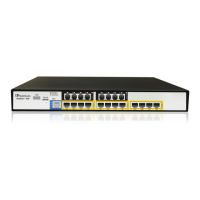Call tear-down: The SIP connection is terminated once the QSIG call is complete.
The Release Complete message is encapsulated in the SIP BYE message that
terminates the session.
To enable QSIG tunneling:
1. In the Digital Gateway Parameters page (Configuration tab > VoIP menu > GW and
IP to IP > Digital Gateway > Digital Gateway Parameters), set the 'Enable QSIG
Tunneling' parameter (EnableQSIGTunneling) to Enable on the originating and
terminating devices.
2. Configure the QSIGTunnelingMode parameter for defining the format of encapsulated
QSIG message data in the SIP message MIME body (0 for ASCII presentation; 1 for
binary encoding).
3. Set the ISDNDuplicateQ931BuffMode parameter to 128 to duplicate all messages.
4. Set the ISDNInCallsBehavior parameter to 4096.
5. Set the ISDNRxOverlap parameter to 0 for tunneling of QSIG overlap-dialed digits
(see below for description).
The configuration of the ISDNInCallsBehavior and ISDNRxOverlap parameters allows
tunneling of QSIG overlap-dialed digits (Tel to IP). In this configuration, the device delays
the sending of the QSIG Setup Ack message upon receipt of the QSIG Setup message.
Instead, the device sends the Setup Ack message to QSIG only when it receives the SIP
INFO message with Setup Ack encapsulated in its MIME body. The PBX sends QSIG
Information messages (to complete the Called Party Number) only after it receives the
Setup Ack. The device relays these Information messages encapsulated in SIP INFO
messages to the remote party.
23.6 ISDN Non-Facility Associated Signaling (NFAS)
In regular T1 ISDN trunks, a single 64 kbps channel carries signaling for the other 23 B-
channels of that particular T1 trunk. This channel is called the D-channel and usually
resides on timeslot # 24. ISDN Non-Facility Associated Signaling (NFAS) enables the use
of a single D-channel to control multiple PRI interfaces.
With NFAS it is possible to define a group of T1 trunks, called an NFAS group, in which a
single D-channel carries ISDN signaling messages for the entire group. The NFAS group’s
B-channels are used to carry traffic such as voice or data. The NFAS mechanism also
enables definition of a backup D-channel on a different T1 trunk, to be used if the primary
D-channel fails.
The device supports up to 12 NFAS groups. Each group can comprise up to 10 T1 trunks
and each group must contain different T1 trunks. Each T1 trunk is called an ‘NFAS
member’. The T1 trunk whose D-channel is used for signaling is called the ‘Primary NFAS
Trunk’. The T1 trunk whose D-channel is used for backup signaling is called the ‘Backup
NFAS Trunk’. The primary and backup trunks each carry 23 B-channels while all other
NFAS trunks each carry 24 B-channels.
The NFAS group is identified by an NFAS GroupID number (possible values are 1 to 12).
To assign a number of T1 trunks to the same NFAS group, use the NFASGroupNumber_x
= groupID (where x is the physical trunk ID (0 to the maximum number of trunks) or the
Web interface (see 'Configuring Trunk Settings' on page 277).
The parameter ‘DchConfig_x = Trunk_type’ defines the type of NFAS trunk. Trunk_type is
set to 0 for the primary trunk, to 1 for the backup trunk, and to 2 for an ordinary NFAS

